Moving into a new home always has two sides: the excitement of a fresh start and the pressure of logistics. Between boxes, packing tape, and the eternal question “where did I put that cable?”, the process can quickly turn into a costly headache. That’s where the golden rules come in – simple yet brilliant strategies that make the difference between a draining move and one that runs like clockwork.
Whether it’s about protecting fragile items, planning your time, or small tricks that save your sanity, the right rules don’t just make life easier – they also give you the space to actually enjoy your new beginning.
In this article, you’ll discover the 12 best golden packing rules, inspired by expert know-how and the creative hacks of people who have been through dozens of moves.
Why Packing Rules Matter
Let’s be honest: nobody wakes up excited to hunt for boxes and wrap silverware in old newspapers. Still, the way you organize your packing can shape your entire moving experience. It’s not just about “putting things in boxes” – it’s about creating a plan that saves you time, money, and – maybe most importantly – your peace of mind.
Here’s why these rules are essential:
- Time savings — Without a strategy, you’ll find yourself packing and unpacking the same items twice. With clear rules, you know exactly where to start and what comes next.
- Protecting valuables — From your grandmother’s china to the laptop you use every day, proper packing drastically lowers the risk of unpleasant accidents.
- Lower costs — Choosing the right materials and planning ahead can save serious money in the long run. And by eliminating unnecessary items from the start, you’ll also cut down on transport costs.
- A smoother transition — When boxes are labeled and organized, settling into your new home becomes much simpler. No more spending evenings hunting for bed linens or your phone charger.
In short, packing rules are the “unwritten manual” of moving – something only people who’ve been through dozens of relocations know by heart. And these very rules can turn your experience from a dreaded chore into a logical, and even satisfying, process.
12 Golden Rules for a Stress-Free Move
1. Color-Coding by Room – Turn Your Boxes into a Visual GPS
A simple marker isn’t enough. Color-coding speeds up your move and cuts down on mistakes.
- Choose 6–8 clear colors (yellow = kitchen, green = bathroom, blue = bedroom, red = living room).
- Apply colored duct tape on at least two visible sides of each box.
- Write on every box: the room name, box number (e.g., Kitchen 3/10), a short content description, and a “priority tag” (Open First).
- Add symbols (Fragile, This Side Up) for instant recognition.
Moishe’s Pro Tip: Post a large color legend at the new location and use QR codes for a digital inventory — advanced, but game-changing.
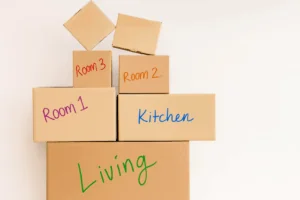
2. Create a “No-Pack Zone” – The Movers’ Off-Limits Corner
This is the area where you place everything that should stay with you.
- Include: documents, cash, cards, laptop, chargers, medications, keys.
- Mark the area clearly with a sign or colored tape.
- Keep these items close — never load them onto the truck.
Moishe’s Pro Tip: Think of your “no-pack zone” as your own mini airport terminal — everything here stays on board.
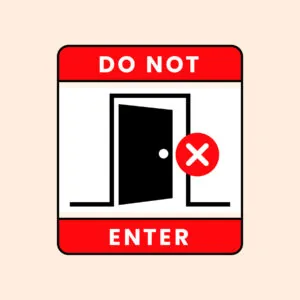
3. The “First-Day Box” – Your Survival Kit
When you arrive at your new place, you don’t want to dig through 20 boxes just to find towels or sheets.
- Include: toilet paper, towels, pajamas and clothes for a few days, plates/glasses, utensils, a cleaning kit, essential skincare (consider buying travel-sized just for this box), medications, charger, adapter, power strip.
- Label it clearly: OPEN FIRST.
- Carry it with you — don’t leave it on the truck.
Moishe’s Pro Tip: Toss in a snack or some instant coffee. Tomorrow-you will be endlessly grateful.
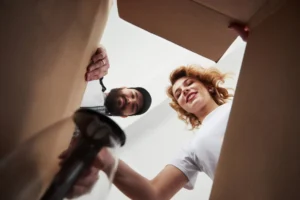
4. Stick to the Weight Limit – 50 lbs (≈23 kg) per Box
Weight is the key to a safe move.
- Heavy items → small boxes (books, canned goods).
- Light items → large boxes (clothes, linens).
- Test: if you can’t lift it comfortably, it’s too heavy.
Pro level: Use your bathroom scale for a quick check.

5. Start with Seldom-Used Spaces
Order matters. Begin with areas that won’t affect your daily life.
- Guest rooms, attics, secondary closets.
- Then move gradually toward the kitchen and bedroom.
- This way you’ll see progress without disrupting your routine.
6. Pack by Category and Mark FRAGILE
Don’t mix shoes with dishes — or metal with porcelain.
- Create themed boxes: books, dinnerware, clothes.
- Mark FRAGILE clearly on at least two sides.
- Fill empty spaces with paper or linens for protection.
Moishe’s Pro Tip: Use towels and sheets as padding for fragile items. Two problems solved at once.
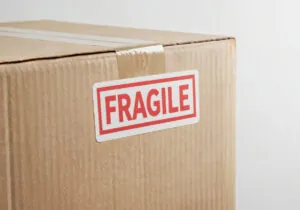
7. The Kitchen – The Riskiest Box
The kitchen requires extra care.
- Plates → pack vertically in a dish pack.
- Gaps → fill with crumpled paper or towels.
- Keep a small kitchen kit separate (pan, utensils, mug, sponge).
Moishe’s Pro Tip: Pack essential spices in a small jar. You’ll want those first meals in your new home to have flavor!

8. Fridge & Freezer – Prep 24 Hours in Advance
An unprepared fridge can cause major discomfort.
- Empty and defrost at least 24 hours before the move.
- Clean and leave doors slightly open.
- If storing, place baking soda or activated charcoal to prevent odors.
9. Clothes on Hangers – Fast and Neat
There’s no need to fold everything hanging in your closet.
- Wardrobe boxes: metal bar + clothes go straight from closet to box.
- Heavy-duty bags: slip them over hangers as a budget-friendly option.
- Clothes arrive clean and wrinkle-free.
Moishe’s Pro Tip: For clothes not on hangers, use vacuum-sealed bags — a huge space saver.
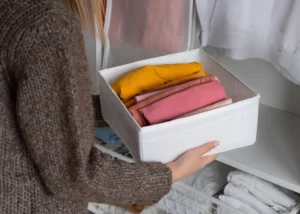
10. What Moving Companies Won’t Accept
The “non-allowables” list is stricter than you might think.
- Aerosols, propane, paint, toxic chemicals.
- Perishable food, live plants.
- Cash, jewelry, and personal documents.
Moishe’s Pro Tip: Always check your mover’s official list before packing.
11. Know the Limits of Liability if You Pack Yourself
If you go the DIY route for packing, be aware of the risks.
- Compensation is limited if packaging isn’t up to standard.
- Fragile items may not be covered at all.
- Undeclared hazardous materials are your personal responsibility.
If it feels overwhelming, choose a moving company that offers professional packing services.
12. Community Hacks – Tested in the Real World
The best tricks often come from people who’ve moved dozens of times.
- Themed tape colors: red = Christmas décor, blue = kids’ room.
- Second-hand duffel bags: cheap, durable, perfect for textiles.
- Personal toolkit: box cutter, screwdrivers, packing tape — always keep within reach.
- Moving playlist: energy matters; music makes those boxes feel lighter.
The Ideal Packing Timeline
Moves don’t happen “last minute” without consequences. A well-planned timeline gives you control and keeps stress in check. Think of it like a training schedule: each week has its role, and Moving Day simply becomes the natural final step.
6–8 Weeks Before
- Declutter big time: Get rid of clothes, décor, or small furniture you no longer need. Donate or sell online.
- Organize important documents: passports, contracts, school records. Keep them together in a separate folder.
- Book your movers: Secure your date early (weekends and month-end slots fill up quickly).
4–5 Weeks Before
- Start packing seldom-used areas: attic, basement, secondary closets.
- Buy packing supplies: boxes, tape, bubble wrap, markers. (Tip: see our supplies section.)
- Label boxes with your color-coding system and begin a digital inventory.
2–3 Weeks Before
- Move on to main rooms: secondary bedrooms, living room.
- Plan for appliances: measure doorways and prep the fridge/freezer.
- Check the “non-allowables” list: avoid packing anything movers won’t transport.
1 Week Before
- Pack the kitchen: vertical plates, specialty glassware boxes, FRAGILE labels visible.
- Prepare your First-Day Box: toiletries, linens, utensils, cleaning kit.
- Confirm with your movers: exact time, address, and access details.
48 Hours Before
- Keep essentials close: clothes, laptop, medications go into your No-Pack Zone.
- Clean out the fridge and leave doors slightly open.
- Do a sweep of all rooms: balcony, storage closets, bathroom cabinets.
Moving Day (Day Z)
- Supervise the loading: FRAGILE boxes on top, heavy boxes on the bottom.
- Keep your folder handy: IDs, contracts, moving paperwork.
- Do a final walk-through: check outlets, closets, garage—make sure nothing gets left behind.
Extra Tips for Sustainability and Safety
Moving isn’t just about boxes, trucks, and sweat. It can also be an opportunity to do things smarter — in a way that’s planet-friendly and safer for both you and your belongings.
Sustainability — More Than a Trend, a Strategy
Moves often leave behind mountains of cardboard and plastic. The good news? There are alternatives.
- Reusable plastic bins — Renting them is one of the easiest eco-friendly solutions. They’re sturdier, easier to stack, and you don’t have to recycle them after the move.
- Tote bags and foldable crates — Perfect for clothes, textiles, or lightweight items. After the move, you can reuse them for storage.
- Smart recycling — Leftover cardboard boxes can be donated or reused by someone else moving soon. Local Facebook groups or Craigslist are full of people grateful for free boxes.
- Moishe’s Touch: With every eco-friendly move, you not only save money long term but also leave a lighter footprint on the planet. And who wouldn’t want to start a new chapter with a fresh, green beginning?
Safety — For Your Items and For You
Packing isn’t complicated… until you realize your laptop ended up under a cast-iron pan. The basics of safety aren’t negotiable.
- Back up your digital files — Before boxing up your laptop or PC, save everything to the cloud or an external hard drive. You’ll sleep easier knowing your data is safe even if something happens on the road.
- Keep a first-aid kit handy — Moves often come with small cuts or scrapes from box cutters and tape. A simple kit (bandages, disinfectant) is more important than you think.
- Eliminate hidden risks — Check floors for cords or sharp objects on moving day. One fall can slow down the entire process.
- Proper storage — If you need to leave items in storage, choose a safe, well-ventilated facility. (See our storage tips for guidance.)
- Moishe’s Touch: Safety rules aren’t just for belongings — they’re for you, your family, and the people helping you. A move without accidents is a successful move.
Conclusion: Preparation Is the Key to a Successful Move
Moves are never truly simple — but they can be predictable. When you follow clear rules, from color-coding your boxes to packing your First-Day Box, you turn chaos into a plan. And most importantly, you preserve your energy for what really matters: the start of a new chapter.
With the right organization, sustainability in mind, and a touch of creativity, every step becomes easier. And if you want to take it all to the next level, choose a team that knows how to make these rules work for you.
At Moishe’s, we offer more than just moving boxes. We deliver safety, efficiency, and tailored services — whether it’s local moving, long-distance relocations, or even white-glove service for your most valuable items.
The perfect move isn’t a myth. It’s the result of smart preparation and choosing the right partner.
Get a Free Moving Quote Today
